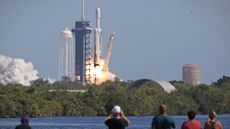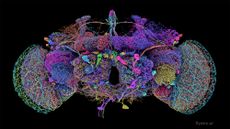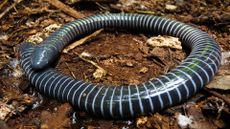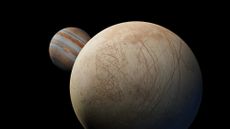New Horizons finds that Pluto is bigger, icier than previously thought


It turns out that Pluto isn't as small as scientists thought: NASA's New Horizons probe has sent imagery back to Earth showing that the planet's diameter is 1,473 miles (plus or minus 12.4 miles), making it 30 miles wider than the dwarf planet Eris, whose discovery caused Pluto’s demotion from being a full-fledged planet in 2006.
"This settles the debate about the largest object in the Kuiper Belt," New Horizons principal investigator Alan Stern told NBC News. Data sent back from the probe also shows that Pluto has a polar ice cap that is more methane-rich than the dark bands around its equator; that Charon, the largest moon, is 751 miles across; and that the smaller, icy moons Nix and Hydra are just 20 and 30 miles wide, respectively.
New Horizons was launched nine-and-a-half years ago, with the mission to map Pluto and Charon and study Pluto's thin atmosphere. It will make its closest flyby past Pluto on Tuesday morning, but since it will take almost five hours of travel time at the speed of light for the all-clear signal to reach the Earth, scientists won't know if it survived the mission until about 9 p.m. ET. "Tomorrow evening's going to be a little bit of drama," Stern said.
Subscribe to The Week
Escape your echo chamber. Get the facts behind the news, plus analysis from multiple perspectives.

Sign up for The Week's Free Newsletters
From our morning news briefing to a weekly Good News Newsletter, get the best of The Week delivered directly to your inbox.
From our morning news briefing to a weekly Good News Newsletter, get the best of The Week delivered directly to your inbox.
Sign up for Today's Best Articles in your inbox
A free daily email with the biggest news stories of the day – and the best features from TheWeek.com
Catherine Garcia has worked as a senior writer at The Week since 2014. Her writing and reporting have appeared in Entertainment Weekly, The New York Times, Wirecutter, NBC News and "The Book of Jezebel," among others. She's a graduate of the University of Redlands and the Columbia University Graduate School of Journalism.
-
 4 ways to give back this holiday season
4 ways to give back this holiday seasonThe Explainer If your budget is feeling squeezed, remember that money is not the only way you can be generous around the holidays
By Becca Stanek, The Week US Published
-
 4 tips for hosting an ecofriendly Thanksgiving
4 tips for hosting an ecofriendly ThanksgivingThe Week Recommends Coming together for the holidays typically produces a ton of waste, but with proper preparation, you can have an environmentally friendly gathering.
By Theara Coleman, The Week US Published
-
 Jussie Smollet conviction overturned on appeal
Jussie Smollet conviction overturned on appealSpeed Read The Illinois Supreme Court overturned the actor's conviction on charges of staging a racist and homophobic attack against himself in 2019
By Peter Weber, The Week US Published
-
 Dark energy data suggest Einstein was right
Dark energy data suggest Einstein was rightSpeed Read Albert Einstein's 1915 theory of general relativity has been proven correct, according to data collected by the Dark Energy Spectroscopic Instrument
By Peter Weber, The Week US Published
-
 New DNA tests of Pompeii dead upend popular stories
New DNA tests of Pompeii dead upend popular storiesSpeed Read An analysis of skeletal remains reveals that some Mount Vesuvius victims have been wrongly identified
By Peter Weber, The Week US Published
-
 NASA's Europa Clipper blasts off, seeking an ocean
NASA's Europa Clipper blasts off, seeking an oceanSpeed Read The ship is headed toward Jupiter on a yearslong journey
By Peter Weber, The Week US Published
-
 Detailed map of fly's brain holds clues to human mind
Detailed map of fly's brain holds clues to human mindSpeed Read This remarkable fruit fly brain analysis will aid in future human brain research
By Peter Weber, The Week US Published
-
 Blind people will listen to next week's total eclipse
Blind people will listen to next week's total eclipseSpeed Read While they can't see the event, they can hear it with a device that translates the sky's brightness into music
By Peter Weber, The Week US Published
-
 Melting polar ice is messing with global timekeeping
Melting polar ice is messing with global timekeepingSpeed Read Ice loss caused by climate change is slowing the Earth's rotation
By Peter Weber, The Week US Published
-
 An amphibian that produces milk?
An amphibian that produces milk?speed read Caecilians, worm-like amphibians that live underground, produce a milk-like substance for their hatchlings
By Peter Weber, The Week US Published
-
 Jupiter's Europa has less oxygen than hoped
Jupiter's Europa has less oxygen than hopedspeed read Scientists say this makes it less likely that Jupiter's moon harbors life
By Peter Weber, The Week US Published